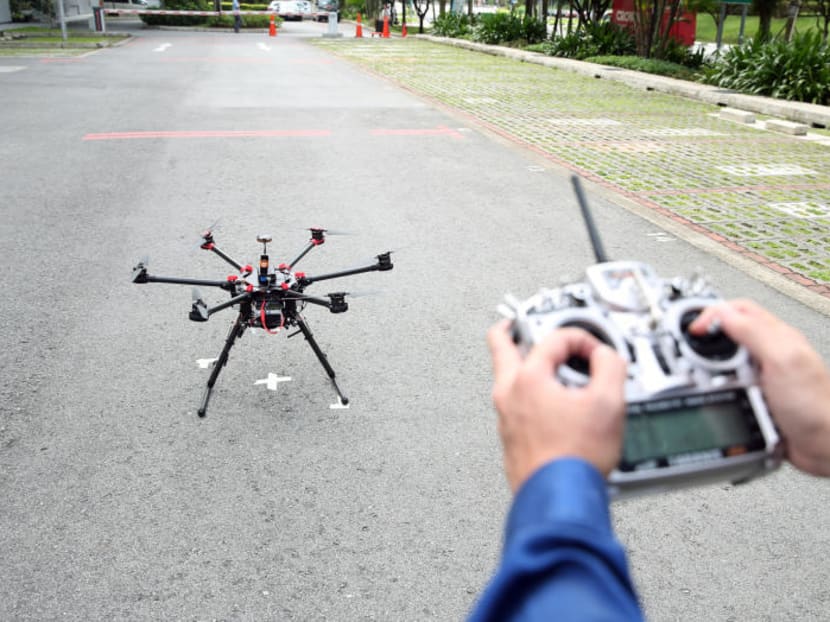Designated common spaces to fly unmanned aircraft to be set up
SINGAPORE — Designated spaces for hobbyists to fly their unmanned aircraft will soon be made available, with details to be announced in the coming months.

Drones are not allowed over restricted, danger, protected, or prohibited areas and not within 5km of an aerodrome or airbase.
- The Ministry of Transport has accepted a key recommendation made by a panel that advises on unmanned aircraft
- The panel said the development of flying areas will help provide common spaces for recreational operators to gather, among others
- Unmanned aircraft enthusiasts welcome the ministry’s plan to open more flying sites as there are few of these
SINGAPORE — Designated spaces for hobbyists to fly their unmanned aircraft will soon be made available, with details to be announced in the coming months.
Transport Minister Ong Ye Kung said in a Facebook post on Friday (Jan 15) that his ministry has accepted the second set of recommendations made by the Unmanned Aircraft Systems Advisory Panel.
His post comes after a visit to a flying field run by the Radio Modellers Singapore Flying Club — an aeromodelling club set up since 1954 — along Port Road near Labrador Park.
A key recommendation made by the panel is to develop flying areas, which they said will help inculcate an interest in the hobby, provide common spaces for recreational operators to gather and foster a culture of safety among the unmanned aircraft community.
The panel had earlier proposed for all unmanned aircraft weighing above 250g to be registered with the authorities before they can be allowed to fly, and for drone operators to be above the age of 16.
Unmanned aircraft enthusiasts who spoke to TODAY welcome the ministry’s plan to open more flying sites.
Drone hobbyist Farhan Tahir, who declined to reveal his age, said that there are few flying sites in Singapore.
Drones are not allowed over restricted, danger, protected, or prohibited areas and not within 5km of an aerodrome or airbase.
This means that operators are not allowed to fly over or near Changi airport, police camps and military bases, nature reserves and elected recreational parks under the National Parks Board that carry “no-drone” signs.
Mr Farhan, the administrator of the Facebook hobby group, Universal Drones – Singapore, said: “If we were to look at the map recommended by the Civil Aviation Authority of Singapore, once we cut off the restricted areas and non-crowded areas, drone pilots are left with very limited locations in Singapore to practise their hobby.”
Another enthusiast, Mr Ronald Yong, 45, hopes the upcoming fly zones can be developed in different parts of Singapore so that hobbyists have more choices of locations to fly their unmanned aircraft.
The general manager of Singapore Hobby Supplies, which he describes as a one-stop shop for drone enthusiasts, added: “It would also space out the hobbyists and ensure safe flying. We don’t want too many people crowding at the (fly zones) we currently have.”
RECOMMENDATIONS
The Unmanned Aircraft Systems Advisory Panel is chaired by Mr Timothy De Souza, a veteran pilot from the Republic of Singapore Air Force, with 11 members representing key stakeholder groups, including those in the unmanned aircraft systems industry and interest groups, government agencies and grassroots organisations.
In its latest set of recommendations, the panel also proposed that the flying areas operate under a series of guidelines.
The areas should not compromise the safety of other airspace users such as military and commercial operations or jeopardise national security. They should also be large enough for several operators to fly their unmanned aircraft concurrently and in a safe manner, and are affordable to enter, among other things.
“To be optimally effective, unmanned aircraft flying areas need to ensure safety and balance the needs of the public and operators,” the panel said.
In coming up with possible operating models for the flying areas, the panel also studied examples of such sites in several countries, such as the United States Federal Aviation Administration’s sites as well as indoor and outdoor flying areas in Japan and South Korea.
“We are convinced that the development of established unmanned aircraft flying areas is the most effective way to grow a community of unmanned aircraft operators and build a culture of safety and responsibility on a sustained basis.
“Taking into consideration the Covid-19 situation, we propose that the Government consider implementing the concept of established unmanned aircraft flying areas when feasible,” the panel said.








